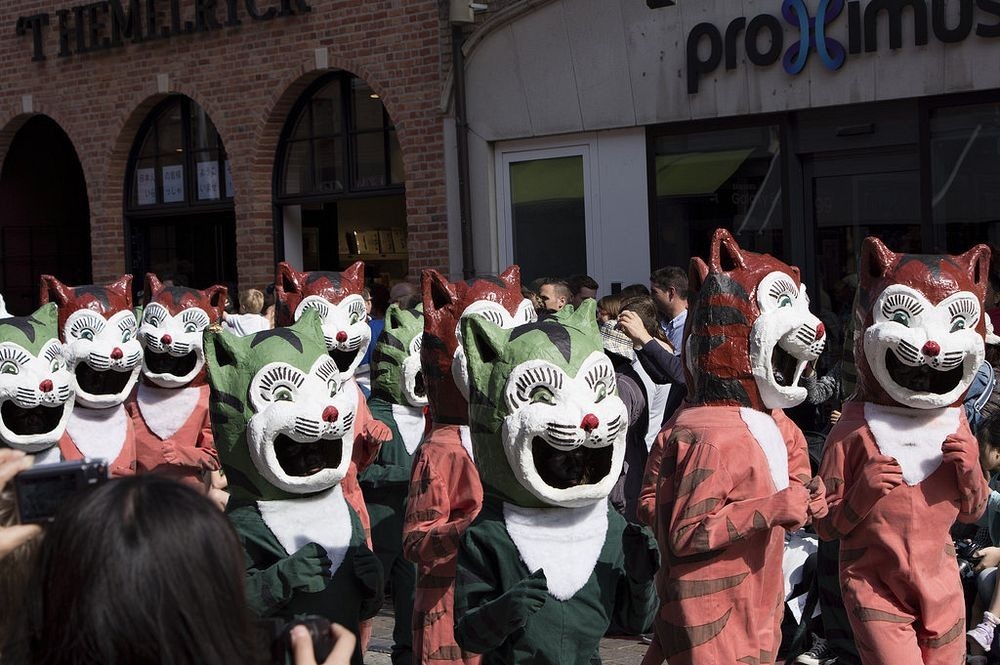Kattenstoet (illuminating the “Cat Festival”) is an exhibition in Ypres, Belgium, dedicated to cats. It has been held every second Sunday in May since 1955. Most recently, the 45th program took place on May 13, 2018. The exhibition is reminiscent of the Ypres Middle Ages, where cats were thrown from the buffalo tower of the Fabric Hall to the town square below.
How it all started
There are various myths about how cats were thrown. It is also possible that cats were involved in witchcraft, and the throwing of cats symbolized the killing of evil spirits. The last recorded event of its kind was in 1817. Another story suggests that cats were brought to the Cloth Hall (Lakenhallen) to control pests. Prior to the modern methods of heating and storage, when cold, wool was stored on the upper floors of the Fabric Hall. Early in the spring heat, after the wool had been sold, the cats were thrown out of the iron tower.
Modern festival
Figuratively reviving the practice at parade ceremonies, the jester throws baby toy cats from Cloth Hall belfry to the crowd, waiting with simple hands to catch one. The throwing of cats from the bench is followed by the burning of a fake witch. Participants in ceremonies often dress like cats, witches, mice, or city dwellers from years past, and the festival also features brass bands and horsemen. About 2,000 people took part in the 2012 show. [5] The festival is a popular tourism event in Belgium and has helped strengthen the local tourism economy near Ypres. 8,000 people visited the event in 2000.
For the past 60 years, the city of Ypres in Belgium has had a famous “Cat Parade” that attracts visitors from all over the country. Kattenstoet, or “Cat Festival”, is held once every three years and mainly includes parades featuring images of big cats, brass bands, marchers, and horsemen. Fun lovers dress like cats, witches, or mice and march through the city to enjoy the crowds. Although everything is gay and fun now, the origins of Kattenstoet are very dark.
Back in the Middle Ages, people were not kind to animals and cats in particular. Many Western European cities at the time engaged in cat-eating rituals in which people gathered cats in a net or rope and hoisted them high into the air over a huge fire. Cats were thought to carry evil spirits along with the Devil himself. So while the poor animals cry out in pain, the crowd roars with laughter. After the animals were burned, the mob gathered charcoal and fire ashes to bring them home.
In the city of Ypres, cats are used as victims in many folkloristic games.
In those days, Ypres, like many cities in the Flanders region of Belgium, had a reputation for its textile industry. Wool was imported into England, and it was woven into fine clothes by highly skilled craftsmen. Both wool and finished products were stored in the Fabric Hall, one of the largest commercial buildings of the time. But the fabric attracted rats, chewing on the fabric and producing unhealthy values.
To control the number of rats, textile traders in Ypres brought in their natural predator, the cat. But cats also breed and soon there were more cats than the city could afford. Thus began the killing of cats. This was a time when cats were considered a symbol of evil, and there was nothing more pleasing to the people of the town than throwing an animal into the metal tower of a local church. When business was not going well, people were sure that there were always a few extra cats thrown out of the window. In time, the killings became a ritual, occurring on ‘Cat Wednesday’, in the second week of Lent.
The pagan practice continued until 1817 when the last massacre took place. The last cat reportedly survived the fall and fled shortly before being caught again. From then until World War I, Cats’ Day was celebrated with the sound of church bells ringing.
In 1938, a group of young boys from the altar organized a kind of cat show. Each had a toy cat. When they got to church they started having a party and then one of the boys climbed on the bell and threw the cat toys on the floor.
The ‘Cat Festival’ lasted mainly a local festival until the 1950’s when folkloristic parades became a new phenomenon throughout West Flanders. On the second Sunday of Lent in 1955, the first beautiful exhibition was organized with 1,500 others, all dressed in fine clothes. Since then, every three years the city has been celebrating the Cat Festival.






